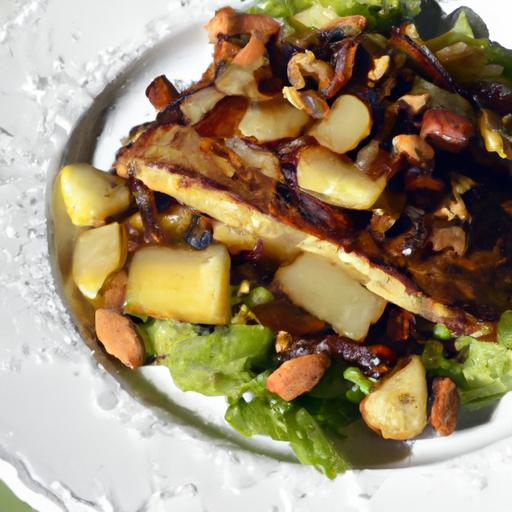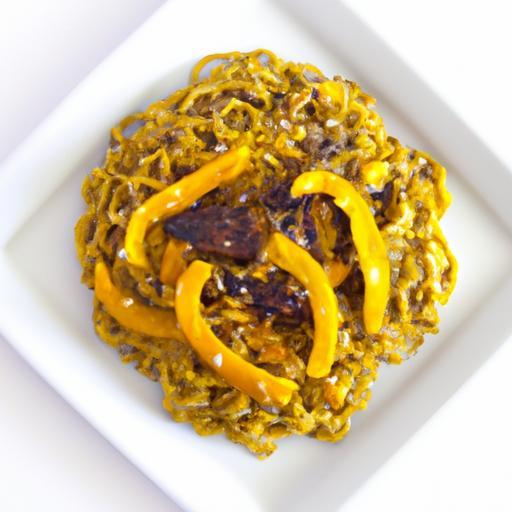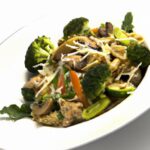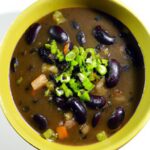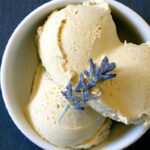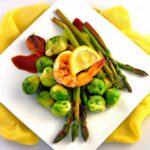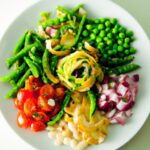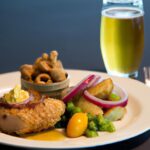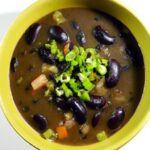In the vibrant world of plant-based cuisine, the quest to create vegan dishes that not only taste incredible but also look irresistibly authentic has taken center stage. Gone are the days when vegan food was merely a niche alternative; today, it’s a culinary adventure filled with color, texture, and creativity. Crafting vegan dishes that rival their traditional counterparts in appearance is an art form that invites both innovation and respect for nature’s bounty. Whether you’re a seasoned chef or a curious home cook, this exploration will guide you through techniques and ideas to transform humble ingredients into stunning plates that celebrate the beauty and diversity of vegan cooking-proving that plant-based can be as visually delightful as it is delicious.
Crafting Vegan Dishes That Look Delightfully Authentic
Crafting vegan dishes that look delightfully authentic unlocks a world of culinary creativity where plant-based textures and vibrant flavors come together to mimic classic comfort foods with stunning precision. The secret lies in understanding how to master texture, select premium ingredients, and elevate presentation so every bite delights both the eyes and the palate.
Prep and Cook Time
Preparation: 20 minutes
Cooking: 35 minutes
Total: 55 minutes
Yield
Serves 4 generous portions
Difficulty Level
Medium – Perfect for cooks ready to experiment and refine their plant-based techniques
Ingredients
- 1 cup cooked chickpeas, mashed for texture
- 1/2 cup cooked quinoa, cooled
- 1/2 cup finely chopped shiitake mushrooms for umami depth
- 1 small onion, finely minced
- 2 cloves garlic, minced
- 3 tablespoons ground flaxseed mixed with 9 tablespoons water (flax egg)
- 1/4 cup nutritional yeast for cheesy notes
- 2 tablespoons soy sauce or tamari to enhance savoriness
- 1 teaspoon smoked paprika for warmth and subtle smoke
- 1/2 teaspoon sea salt (adjust to taste)
- Freshly ground black pepper, to taste
- 2 tablespoons olive oil for sautéing
- 1/2 cup panko breadcrumbs for crunch
- Fresh herbs (parsley, thyme) for garnish
Instructions
- Prepare the flax egg: Combine ground flaxseed with water in a small bowl. Let it thicken for 5-10 minutes until gel-like.
- Sauté aromatics: Heat olive oil over medium heat in a skillet. Add minced onion and garlic, sauté until golden and fragrant, about 5 minutes. Add chopped mushrooms; cook until moisture evaporates and mushrooms are slightly caramelized, about 7 minutes.
- Mix base ingredients: In a large mixing bowl, combine mashed chickpeas, cooked quinoa, sautéed mushroom mixture, flax egg, nutritional yeast, soy sauce, smoked paprika, salt, and pepper. Stir thoroughly until the mixture binds well. Add panko breadcrumbs gradually until the mixture holds shape but remains moist.
- Shape and chill: Form the mixture into patties or balls, roughly 2.5-3 inches in diameter. Place on a parchment-lined tray and refrigerate for 20 minutes to firm up, ensuring easier cooking and better texture retention.
- Cook to perfection: Heat a non-stick pan over medium heat with a splash of olive oil. Cook patties for 4-5 minutes on each side, until golden brown and crisp. Flip carefully to maintain structure. Alternatively, bake at 375°F (190°C) for 20 minutes, flipping halfway.
- Garnish and serve: Plate with fresh herbs and a drizzle of your favorite vegan sauce or aioli. Serve immediately for optimum taste and appearance.
Tips for Success
- Texture balancing: The combination of chickpeas and quinoa offers both creaminess and bite. For a firmer texture, increase quinoa slightly or add more breadcrumbs.
- Mushrooms: Using shiitake provides deep umami, but cremini or porcini can be substituted based on availability.
- Make-ahead: Patties can be formed and frozen raw; cook directly from frozen, adding a few minutes to cooking time.
- Binding alternatives: If allergic to flaxseed, chia seeds or vegan mayonnaise can substitute.
- Presentation: Use a ring mold to shape patties perfectly uniform; sprinkle extra herbs or edible flowers for vibrant color.
Serving Suggestions
Pair these plant-based creations with a refreshing, zesty slaw or a vibrant beetroot hummus for contrast. Top with microgreens or a sprinkle of toasted sesame seeds for added visual interest and crunch. Serve alongside a rustic whole grain bread or nestled between toasted vegan buns to create a picture-perfect plant-based burger.

| Nutrient | Per Serving |
|---|---|
| Calories | 310 kcal |
| Protein | 14 g |
| Carbohydrates | 40 g |
| Fat | 8 g |
For deeper insights into flavor balancing in vegan cooking, explore our Vegan Flavor Balancing Guide. Additionally, the Vegan Society offers authoritative resources on plant-based nutrition and cooking techniques.
Q&A
Q&A: Crafting Vegan Dishes That Look Delightfully Authentic
Q1: Why is the appearance of vegan dishes important?
A1: Just as first impressions matter in social settings, the visual appeal of a dish sets the tone for the dining experience. When vegan dishes look authentically appetizing, they not only entice curiosity but also challenge the stereotype that plant-based meals are bland or boring. A captivating presentation sparks excitement and openness before the first bite.
Q2: How can I make vegan dishes look like traditional, non-vegan meals?
A2: The secret lies in textures and colors. Use plant-based ingredients that mimic the look and feel of animal products-think jackfruit pulled “pork,” creamy cashew-based sauces, and mushrooms that lend a meaty bite. Incorporate familiar plating styles and garnishes just as you would with classics, so the dish visually bridges tradition and innovation.
Q3: What role do plating and presentation play in authenticity?
A3: Immensely! Presentation is the art of storytelling on a plate. By arranging vegan foods in familiar shapes, layers, and sauces (think: vegan lasagna with distinct layers, or golden tofu nuggets arranged like chicken wings), you create an immediate visual connection to beloved dishes, making the experience both nostalgic and novel.
Q4: Are there specific ingredients known for enhancing the authentic look?
A4: Absolutely. Nutritional yeast adds that cheesy golden hue in sauces; beet juice or powder can replicate the rosy blush of meats; agar-agar gel can help create firm, sliceable vegan “cheeses” or terrines. Incorporate smoky spices like smoked paprika or liquid smoke to simulate the look and aroma of grilled or roasted foods.
Q5: How can textures enhance the perception of authenticity in vegan cooking?
A5: Texture is the unsung hero that transforms flavor into a believable experience. Chewy seitan, crispy tofu skins, or crunchy nut crusts replicate mouthfeel sensations associated with traditional proteins. When bite and chew align with sight, the brain accepts the dish as a genuine, satisfying meal.
Q6: What tips do you have for home cooks seeking to craft visually authentic vegan dishes?
A6: First, embrace experimentation-swap ingredients and test what looks and feels right. Invest in colorful fresh produce and use natural dyes from turmeric, matcha, or spirulina to adjust hues. Use tools like ring molds or piping bags to create neat shapes and layers. Lastly, study plating from your favorite dishes and mimic their style with plant-based twists.
Q7: Can authentic-looking vegan dishes influence people’s attitudes toward veganism?
A7: Very much so. When vegan meals look as hearty and appealing as traditional fare, they lower psychological barriers and invite more people to try them without prejudice. This visual authenticity reassures diners that they’re not sacrificing anything and can expand their culinary horizons joyfully.
Q8: Where can readers find inspiration for creating their own vibrant, authentic vegan dishes?
A8: Dive into cookbooks by vegan chefs who specialize in fusion and comfort foods, explore food blogs rich with step-by-step visuals, and watch cooking shows that celebrate plant-based creativity. Social media platforms like Instagram and Pinterest are also treasure troves for stunning vegan plate compositions waiting to inspire your next kitchen masterpiece.
Crafting vegan dishes that radiate genuine authenticity is both a culinary art and an inviting conversation starter-melding the familiar with the imaginative to delight eyes and taste buds alike.
The Conclusion
In the vibrant world of plant-based cuisine, the art of crafting vegan dishes that look delightfully authentic is more than just a culinary challenge-it’s a celebration of creativity, culture, and compassion. By mastering textures, colors, and presentation, you can transform humble ingredients into visual feasts that delight the eye and satisfy the soul. Whether you’re inspiring seasoned chefs or curious home cooks, remember that authenticity in vegan cooking is not about imitation alone, but about honoring flavors and traditions while embracing innovation. So, let your kitchen become a canvas where plants tell their delicious stories-beautifully, boldly, and authentically.